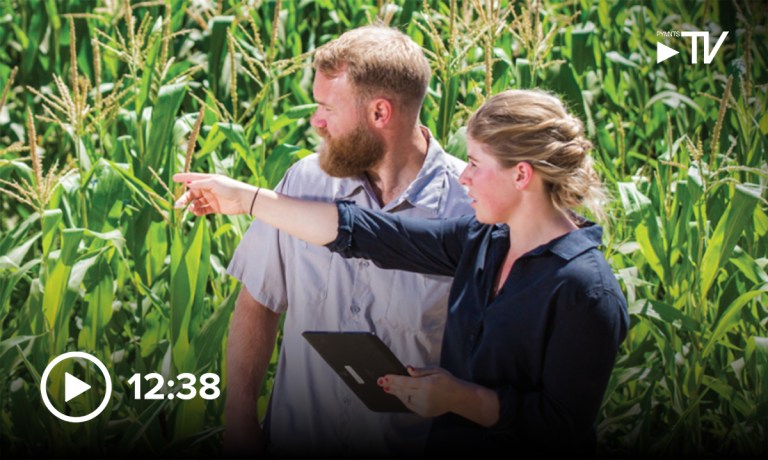
Technology has long had a profound impact on farming practices. With the advent of artificial intelligence, the growing intersection of AgTech, finance and robotics is helping ensure that the future of agriculture stays fertile.
“AI and machine learning are not new technologies,” Ceres AI CEO Ramsey Masri told PYMNTS’ CEO Karen Webster. “They’ve been around for over 20 years, but only recently have they become mainstream, thanks to broader awareness and application.”

In a world where external factors, like population growth and an evolving climate, are exerting unprecedented pressure on agricultural systems, the need for innovation in farming practices is urgent. As the global demand for food continues to rise, traditional methods of agriculture are proving increasingly inadequate to meet the challenge — as are the traditional methods of financing farming initiatives.
“You can’t farm without a loan, and you can’t get a loan without insurance,” Masri explained, noting that this interconnectedness between farming and finance has led to the development of AI tools tailored for both sectors.
As farmers benefit from AI’s ability to predict yields and optimize farming practices, financial institutions are also gaining from AI he added. AI-driven insights, for example, can help banks and insurers manage their portfolios more effectively, reducing the risk of loan defaults and insurance claims.
Read also: Ceres Imaging Reveals Capital Raise, Rebrands to ‘Ceres AI’
The agricultural industry is turning to technological innovations that can enhance efficiency, reduce waste and improve resilience. Against this backdrop, AI enables more precise and efficient management of resources, leading to higher yields and reduced environmental impact.
Masri’s own company, now in its fourth iteration, uses AI to process over 12 billion data points to deliver precise insights that help farmers and financial institutions.
“We speak both the language of farming and finance,” Masri said. “Our technology is designed to meet the needs of all stakeholders in the agricultural ecosystem.”
He explained that climate change is undeniably the greatest threat to modern agriculture. With projections that crop yield failures could be four to five times higher by 2030, farmers are facing unprecedented challenges.
Yet, technology offers a lifeline. AI-driven tools, such as computer vision, can detect anomalies in crops weeks before they become apparent to the human eye or other sensors. Whether it’s too much water, too little, or the onset of a pathogen, AI enables farmers to take preventive actions, thereby reducing losses and improving yields.
This predictive capability is not just beneficial for farmers. It is also invaluable to lenders and insurers who rely on accurate data to manage risk.
“We’re using AI to provide granular insights that are crucial for risk modeling and yield forecasting,” said Masri. “Lenders and insurers can check in on a farmer’s progress throughout the growing season, helping them manage against the downside risk while optimizing for the best possible outcomes.”
The future of agriculture lies at the intersection of AI, AgTech and robotics. Already, companies are developing robotic solutions to handle tedious tasks like weeding, planting and harvesting. For instance, as Masri noted, a company in the United Kingdom has created a trio of robots named Tom, Dick and Harry that are designed to weed, treat soil and enhance crop growth without the use of pesticides.
Masri explained that he sees robotics as a natural extension of AI in agriculture.
“The ability to leverage precision agricultural products is essential for farming large tracts of land with fewer people,” he said. “Robotics, combined with AI, will play a critical role in making farming more efficient and sustainable.”
Robotics could be increasingly crucial in attracting the next generation of farmers. The average age of a farmer today is 62, highlighting a critical challenge: attracting the next generation to agriculture.
Masri shared a telling statistic: “Twenty years ago, three out of four kids stayed on the farm. Ten years ago, it was two out of four. Today, only one stays, and she has to do everything.”
This trend underscores the importance of making farming more efficient and appealing through technology. As farming becomes more data-driven and AI-enabled, younger generations may find it a more attractive and viable career path. Today’s farmers are increasingly digital natives, comfortable with technology and its potential to revolutionize traditional practices.
Looking ahead, Masri noted that the next decade promises even greater advancements as AI becomes an indispensable tool for all stakeholders in the agricultural ecosystem, optimizing operational practices and workflows on a massive scale.
“There’s absolutely an interest from all parties to leverage technologies to source better risk and put practices in place that help the grower farm better, farm with less risk, and as a consequence, help protect and shore up the lending and insurance community as well,” he said.
For all PYMNTS AI coverage, subscribe to the daily AI Newsletter.